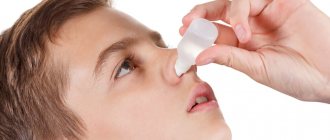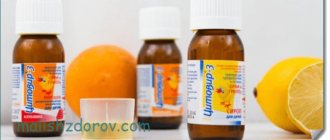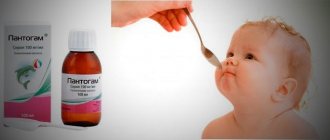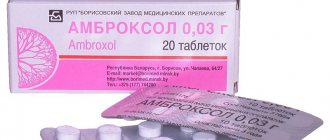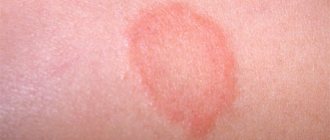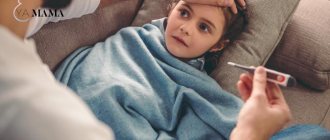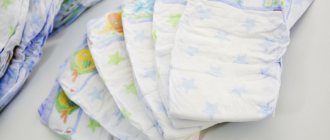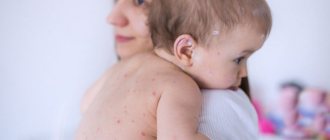A common problem in childhood is a runny nose. Its constant occurrence is due to the structural features of the nasal passages in young children. Then the parents are faced with the question of how to help their child, what children’s drops to give for a runny nose. It is important that they are effective and safe.
What parents need to know - how not to harm their child
Children's drops for the common cold should only be prescribed by the attending physician. Improper use of even the best drug can lead to serious and even dangerous complications. In order for a remedy for rhinitis to cope well with pathology, you need to know the following few rules:
- For children under 6 years of age, it is best to use medication in drop form. Sprays are intended for older children.
- You need to bury your nose in a lying position. First, 1-2 drops are dripped into the right nostril and turn the head to the right and up, then to the left, also turning the head to the left and up. Thus, the product reaches not only the nasal mucosa, but also the sinuses, which significantly increases the therapeutic effect.
- It is strictly forbidden to exceed the dosage recommended by the doctor. Too frequent use of drugs, especially vasoconstrictors, can quickly become addictive and also contribute to the development of drug-induced rhinitis.
- Also, you should not increase the course of treatment with antibacterial nasal drops for children. Although these medications only act locally, they can still cause a host of side effects if used too frequently.
Peculiarities
Absolutely all decongestant drugs that constrict blood vessels can be used only for a limited period of time - depending on the type of active component, this period ranges from 5-10 days. If these medications are not stopped, they will have the opposite effect, increasing swelling of the mucous membranes and provoking the development of drug-induced rhinitis.
It should also be noted that after several days of continuous use, you will have to increase the dosage of the drug: the membranes of the sinuses and nasal passages “get used” to the vasoconstrictor effect, soften and already weakly respond to the usual dose of the drug.
Stages of development of a runny nose
A normal runny nose lasts about 7-10 days. If the pathology is allergic in nature, then the duration of rhinitis is determined by the time of exposure to the allergen. In the development of a runny nose of an infectious nature, there are only three stages of development:
- Reflex. This is the initial stage of the development of the disease, which lasts several hours. It is characterized by pallor of the mucous membrane. Symptoms such as dryness, burning, and repeated sneezing occur.
- Catarrhal. The duration of this stage is about 2-3 days. It is characterized by lacrimation, copious discharge, and swelling of the nasal mucosa. The temperature may rise to 37.2-37.5º C.
- Recovery. The third stage of a runny nose may be final. The mucous membrane is restored, the symptoms disappear. But, since local immunity is still weakened, stopping treatment during this period may contribute to the disease becoming chronic.
Usually, with proper treatment of a runny nose, no problems arise. With normal functioning of the immune system, recovery can occur within 2-3 days. But a weakened body will not be able to cope with pathology so quickly.
Types of drops for children from the common cold - what is the purpose of the drug groups?
A runny nose is a common symptom of many diseases, so successful treatment is aimed at combating the root cause. There are several types of nasal drops:
- vasoconstrictors – relieve swelling, reduce mucus production;
- moisturizing – help restore the functions of the mucous membrane, disinfect cavities;
- homeopathic – relieve congestion;
- oil – help restore nasal breathing, eliminate pathogens;
- antiviral – fight viral agents, support local immunity;
- antibacterial – stop the proliferation of bacteria, reduce the amount of purulent secretion;
- antiseptic – thin mucus, inhibit the growth of pathogenic microorganisms;
- hormonal – relieve swelling, reduce the need to use vasoconstrictors;
- antihistamines – block the action of allergens;
- immunomodulatory – help increase local and general immunity;
- anti-inflammatory – relieve swelling, restore mucous membranes.
What drops to choose for a runny nose for children, in each specific case, should be determined by the doctor. Almost all modern drugs are approved for use in children and, when used correctly, do not cause side effects.
Cure for the common cold: effective decongestants and homeopathic drugs
Rhinitis, or runny nose, is one of the most common respiratory diseases.
It can act as an independent disease or be a symptom of an acute respiratory infection; it almost always accompanies allergies. For treatment, local drugs are usually used in the form of a spray or drops - they have a quick effect and rarely cause side effects. Tablets are also actively used to combat a runny nose. They are necessary to speed up recovery, reduce the risk of complications and relieve general symptoms. Depending on the type of rhinitis, these can be antiviral, antihistamine or homeopathic drugs, as well as broad-spectrum agents.
Children's vasoconstrictor drops
With a runny nose, inflammation of the mucous membrane, severe swelling, and increased mucus production are noted. The child's nasal passages become blocked and a feeling of stuffiness appears. Thanks to the use of vasoconstrictor drops, the lumen of blood vessels decreases (their narrowing), which helps reduce swelling and, accordingly, facilitate nasal breathing.
Today, the pharmaceutical industry offers several groups of drops for the treatment of the common cold, containing various active substances:
- naphazoline;
- oxymetazoline;
- xylometazoline;
- phenylephrine.
Products with naphazoline
Among the drugs that contain naphazoline, the following are considered the most effective:
- "Naphthyzin." These cold drops for children are also effective for nosebleeds. The effect of the drug lasts no more than 4 hours, so it requires four times a day. Children's dosage – 1 drop of 0.01% solution.
- "Sanorin". Intended for the treatment of various types of rhinitis, used to narrow blood vessels and relieve swelling before rhinoscopy. Treatment of runny nose in children is carried out with a 0.05% solution.
Drops based on oxymetazoline
The effect of drugs with such an active substance lasts more than 10 hours. Usually a 2-time use is prescribed. It is strictly forbidden to increase the recommended dosage to avoid side effects. Most often, to cure rhinitis they use:
- "Nazivin." Relieves swelling, thins mucus, makes breathing easier. Can be used for children from 1 year of age.
- "Oxymetazoline." Effectively eliminates congestion and other symptoms of a runny nose.
Preparations with xylometazoline
The effect of drugs with such an active substance is longer - about 10 hours. The recommended frequency of use is 2-3 times a day, depending on the severity of the disease. For babies, a 0.05% solution is used. The most effective are considered:
- "Galazolin." Prescribed for a runny nose caused by a viral infection, an allergic reaction, as well as bacterial rhinitis. It reduces swelling, relieves inflammation, redness of the mucous membrane.
- "Rinostop". In addition to xylometazoline, the drug contains sodium chloride and potassium salts. Thanks to this, nasal discharge becomes less viscous and passes more easily.
Products containing phenylephrine
Nasal drops of this group are recommended for use in children of the first year of life. They tone the walls of blood vessels, reduce allergic swelling, thin out secretions and promote the removal of mucus. “Vibrocil” and “Nazol Baby” are considered the most effective. The first product is also available in the form of a nasal gel.
Types of tablets for runny nose and congestion
Unlike topical medications, the range of tablets for the treatment of colds and runny nose is much wider. Depending on the clinical picture and severity of the disease, almost any remedy can be selected. The choice of a specific medication is selected based on the diagnostic results and the patient’s well-being. To combat nasal congestion and runny nose, antiviral, antihistamine, immunomodulatory, and antimicrobial drugs are used. Almost all products are available in different dosages, so you can choose tablets for both adults and children.
Antiviral
Prescribed only for acute respiratory viral infections; antiviral drugs are taken in a limited course for the treatment and prevention of infection. Depending on the composition and active substance, they can help strengthen the immune system and stimulate the production of antibodies; some drugs act directly on the infectious agent. The most popular medications are those that have complex effects, thereby increasing the effectiveness of therapy and antibiotics.
Arbidol
A domestic product, available in the form of tablets, less often - powder for suspension. The drug has an immunomodulatory effect, stimulates the synthesis of interferon by leukocytes and strengthens cellular immunity. It is most often used to treat group A and B influenza. Arbidol can also be used for prophylaxis during seasonal exacerbation of acute respiratory viral infections; the drug has a prolonged protective effect that lasts up to several months. The tablets can be used for children from 2 years of age and during pregnancy.
Moisturizing nasal products for children
The most popular way to treat rhinitis in children is the use of moisturizers. For young children they are produced in the form of drops, for older children in the form of sprays. The principle of action of such drugs is very simple: sea salt, which is part of the composition, gets on the inflamed mucous membrane, moisturizes it, tones the blood vessels. As a result, mucus production decreases and nasal breathing normalizes. List of moisturizing drops for runny nose for children over 1 year old:
- "Aquamaris";
- "Aqualor";
- "Salin";
- "Quix".
Herbal remedies
To facilitate nasal breathing and relieve congestion in a child, herbal preparations are used.
- Ointment "Pinosol". It contains pine, eucalyptus and menthol oils. Prescribed for persistent rhinitis in children.
- Kalanchoe - the juice of this plant is often used in folk medicine. Kalanchoe juice is used to treat difficulty in nasal breathing in children from two years of age. It is instilled into the nose, starting with a few drops, because Kalanchoe juice causes an allergic reaction or a burn to the mucous membrane.
The choice of drug for a runny nose depends on the cause of its occurrence. The age and allergic predisposition of the baby should also be taken into account when choosing a treatment.
Homeopathic medicines
The principle of homeopathic treatment is the introduction of a small amount of a substance that provokes symptoms similar to those of a particular disease. As a result, a protective reaction of the body occurs, which tries to fight the drug that has entered the body. As a result, strong immunity is developed, promoting rapid recovery.
All homeopathic medicines require long-term use. To treat a runny nose, use:
- "Delufen";
- "Luffel";
- "Euphorbium Compositum".
Their main advantage is the absence of side effects. These products strengthen local immunity, restore the nasal mucosa and keep it moist. The use of homeopathic drops is possible for any form of rhinitis.
In what cases are tablets used?
There are dozens of medications to treat colds and runny nose. They are available in topical form (drops, ointment, gel or spray), but tablets are also widely used. Most often they are needed in the following situations:
- prevention and treatment of acute respiratory viral infections and acute respiratory infections in the early stages;
- inability to use or body resistance to local drugs;
- the need for a quick recovery, reducing the risk of complications;
- regular seasonal manifestations of colds;
- general weakness of the body, drowsiness and significant deterioration in well-being;
- treatment of colds without severe runny nose.
Tablets are most often prescribed to adults; for children, it is advisable to select specialized drugs in the form of a syrup with a pleasant taste. This simplifies the treatment process, since the child does not have a protest the next time he takes the medicine.
Tablets contain a higher concentration of the active substance than similar products for topical use. That is why the risk of side effects is significantly higher.
Antibacterial
If bacterial rhinitis develops, drops for the common cold with an antibiotic are prescribed for children. These drugs act directly on the problem: they help destroy pathogenic microorganisms, relieve inflammation and swelling of the mucous membrane. The following children's nasal drops for a runny nose have proven effective in combating a runny nose of a bacterial nature:
- "Isofra";
- "Polydex";
- "Bioparox".
The products are used only as prescribed by a doctor. It is strictly forbidden to reduce or increase the dosage of the drug to avoid serious complications.
Antihistamines
What medications help get rid of swelling of the nasal mucosa of allergic origin? Allergodil is widely used for allergic rhinitis. In addition to the antihistamine effect, the medicine has anti-inflammatory properties.
Decongestants of this group are used for seasonal, year-round allergies to reduce the severity of symptoms of the disease.
Allergodil is allowed from four years of age, one spray twice a day is recommended. Among the contraindications, individual intolerance to the components of the product should be highlighted.
Usually the drug is well tolerated, but increased congestion, rhinorrhea, itching, and sneezing may occur.
Hormonal
In severe forms of allergic rhinitis, as well as in situations where vasoconstrictor drops no longer cope with their task, hormonal nasal agents are prescribed. These drugs contain glucocorticosteroids, which help reduce the body's excessive protective reaction to exposure to allergens. Such drops and sprays for the common cold for children have a local effect and do not enter the systemic bloodstream, which minimizes side effects. The most effective of them:
- "Nasonex";
- "Baconase";
- "Nasobek."
Useful video
Why are vasoconstrictor nasal drops dangerous?
How to relieve nasal congestion without drops?
Vasoconstrictor drops for children – Doctor Komarovsky
What health hazards do nasal drops pose?
Choose decongestant medications correctly, use them only in accordance with the instructions, be sure to consult with your doctor on this issue and do not self-medicate - then the runny nose will go away quickly and will not bother you!
Source
Immunomodulatory
With various forms of runny nose, the immune status of the little patient is not the least important. In addition to the antiviral effect, immunomodulatory drops promote the active development of local immunity, which has a positive effect on the child’s health. Medicines of this kind can be used both for medicinal purposes and for the prevention of viral diseases. Modern pharmacological companies supply the following drugs to pharmacies:
- "Derinat";
- "Poludan";
- "IRS 19".
Anti-inflammatory
One of the main tasks of drops for the common cold is to relieve inflammation of the mucous membrane. Most often, combination products containing an antibiotic and a hormone are used for this purpose. The most effective are considered:
- "Polydex";
- "Sofradex".
Aminocaproic acid can also be classified as anti-inflammatory drugs. It helps reduce inflammation and strengthen blood vessels. It is strictly prohibited to use aminokapron without a doctor’s prescription.
Folk cold drops for children
You can fight various forms of rhinitis with folk remedies. For these purposes, decoctions of medicinal plants that can be instilled into the nose are best suited. Cheap medicinal herbs can be bought at any pharmacy. To prepare a home remedy for a runny nose, you usually use:
- chamomile;
- calendula;
- St. John's wort.
Juices of medicinal plants are no less effective. Here are a few recipes that are good for helping to cope with a runny nose in a child:
Kalanchoe and aloe
These mini-trees are found in almost every home, but not everyone knows about their medicinal properties. When children have a runny nose, it is recommended to drop the juice of these plants into the nose. For this:
- Two leaves of aloe or Kalanchoe are crushed to a paste.
- Squeeze the resulting mixture through cheesecloth.
- The juice is diluted with boiled water in a ratio of 3:1.
- Use this remedy in the form of drops 2-3 times a day until the condition improves.
Garlic
Regular garlic has a powerful anti-inflammatory and strong bactericidal effect. Drops from snot are prepared as follows:
- The cloves (3-4 pieces) are peeled and crushed using a garlic press.
- The resulting mass is poured with olive oil (can be sunflower) and allowed to brew for 7-8 hours.
- The garlic-oil mixture is filtered and instilled into the child’s nose, 1-2 drops in each nostril.
Such medicinal drops for the runny nose for children can cause slight discomfort, but after 1-2 minutes everything goes away. If the burning does not stop, you need to rinse your nose well with water and do not use this product again.
TOP 5 effective drops for children against runny nose
There are a lot of modern medications that help cope with rhinitis as quickly and effectively as possible. How to choose good drops for a runny nose? Which ones are the best? Below are the five most effective drugs for rhinitis:
- "Aqua-Maris". An effective remedy for treating runny nose in children. Available in two forms: spray and drops. Drops are approved for use in newborns from the first day of life. Thanks to the sea water included in the composition, the nasal passages are quickly cleansed and swelling syndrome is reduced.
- "Nazol Baby" A modern and quite effective vasoconstrictor drug. It is used for a runny nose caused by an allergic reaction, ARVI and other infectious diseases. Can be used in children up to one year old.
- "Otrivin Baby." These are effective drops for the common cold for children over one year old. They clean the nasal cavity well, moisturize the mucous membrane, and relieve swelling. For older children they are available in the form of a spray.
- "Polydex". A combined drug that has a complex effect. It contains an antibiotic, a vasoconstrictor component, and a hormone. Reduces the amount of mucus secreted, helps destroy pathogenic microorganisms, and facilitates nasal breathing.
- "Derinat." An immunomodulatory drug that promotes tissue regeneration. Relieves inflammation, has an anti-allergic effect, stimulates the immune system, helps remove toxins.
Despite the fact that today you can find a huge number of children's medications for the common cold, you should not self-medicate. Any medicine can cause unwanted side effects, so consult a doctor before use.
Popular decongestants
At the moment, there are a huge number of different drugs with a vasoconstrictor effect, but they are all based on one type of anticongestant or another.
Ephedrine
At the moment, only one drug based on this component is produced - this is two percent ephedrine hydrochloride. It is an outdated type of decongestant that is effective for a very limited period of time (up to one and a half hours) and at the same time it is quite toxic, so its use is not rational and even dangerous.
Xylometazoline
A number of drugs are produced based on this substance, in particular Otrivin, Xymelin, Xylene, Galazolin, DlyaNos and Xylometazoline.
Actively used for sinusitis, rhinitis and acute respiratory infections. Quickly and effectively constricts blood vessels, eliminates swelling of the mucous membrane and various hyperemias. The effect of the drugs is felt within a minute after use and lasts up to four hours. The maximum period of use is five days.
Not absorbed in blood plasma, can be used from two years of age. Contraindicated for patients with glaucoma, pregnant women, allergy sufferers and people with arterial hypertension. Prescribe with caution to lactating women and pregnant women. The drug is not compatible with tricyclic depressants and MAO inhibitors.
Possible side effects are headache, tachycardia, vomiting, irritation of mucous membranes, hypersecretion, temporary loss of smell.
Naphazoline
Commercial names Naphthyzin, Naphazolin and Sanorin.
An active vasoconstrictor reduces blood flow to the sinuses, increases blood pressure, and is partially adsorbed into the bloodstream. It begins to act two minutes after application, the effect lasts for 5-6 hours. The maximum period of continuous use is one week.
Can be used from the age of twelve. Contraindicated for pregnant women, lactating women, people with diabetes mellitus, glaucoma, tachycardia, atherosclerosis and severe eye diseases. Incompatible with MAO inhibitors, enhances the mutual systemic effect in combination with maprotiline and antidepressants, and also slows down the effect of anesthetics.
Possible side effects are local allergic reactions, tachycardia, systemic reactions in the form of headache and nausea, reactive hyperemia.
